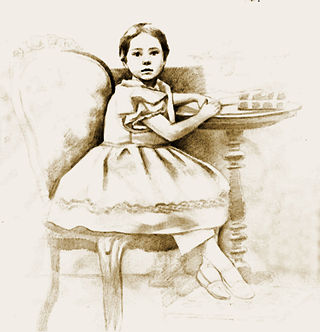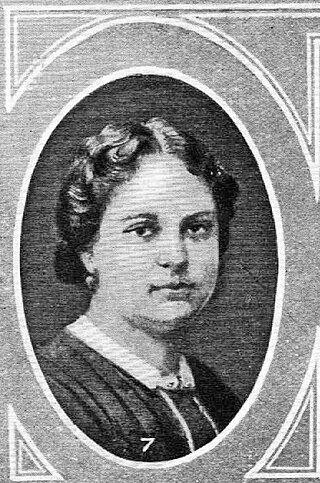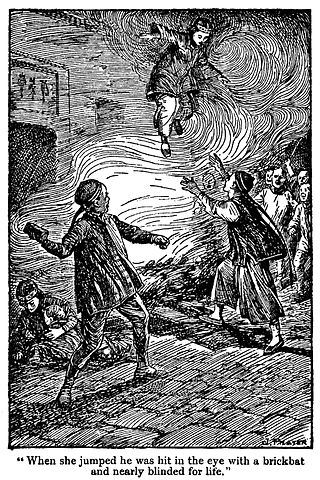
James Hudson Taylor was a British Baptist Christian missionary to China and founder of the China Inland Mission. Taylor spent 54 years in China. The society that he began was responsible for bringing over 800 missionaries to the country who started 125 schools and directly resulted in 20,000 Christian conversions, as well as the establishment of more than 300 stations of work with more than 499 local helpers in all 18 provinces.
OMF International is an international and interdenominational Evangelical Christian missionary society with an international centre in Singapore. It was founded in Britain by Hudson Taylor on 25 June 1865.

Maria Jane Taylor was a British Protestant Christian missionary to China, and "Mother" of the China Inland Mission with her husband, founder James Hudson Taylor. She was a pioneer missionary and educator there for 12 years. In 1858, she married Taylor and was an invaluable assistant and influence to him. In her time with the CIM, she was instrumental in training single women to be missionaries in China, when opportunities for women to serve had been previously dependent on having a missionary husband.

Mary Geraldine Guinness, often known as Mrs. Howard Taylor, was a British Protestant Christian missionary to China, and author of many missionary biographies on the history of the China Inland Mission (CIM).
Marshall B. Broomhall, was a British Protestant Christian missionary to China with the China Inland Mission. He also authored many books on the subject of Chinese missionary work. He was the most famous son of the anti-opium trade activist and General Secretary of the CIM Benjamin Broomhall and Amelia Hudson Taylor. Thus he was also the nephew of the founder of the mission, James Hudson Taylor.

Lammermuir was an extreme clipper ship built in 1864 by Pile, Spence and Company of West Hartlepool for John "Jock" "White Hat" Willis & Son, London. She was the second ship to bear the name. The first Lammermuir had been the favorite ship of John Willis, and was wrecked in the Gaspar Strait in 1863.
Herbert Hudson Taylor, British Protestant Christian missionary to China, author, speaker and eldest son of James Hudson Taylor, founder of the China Inland Mission and Maria Jane Dyer. He served there for over 50 years – the last three as one of the prisoners of the Japanese at the Weifang internment camp during World War II along with Eric Liddell and 1500 others.

Lammermuir, named for the Lammermuir Hills, was a tea clipper designed by William Pile. She was the first clipper owned by Jock Willis Shipping Line. She was a fast sailer, being the second ship home in the 1858-59 tea season. She was a favourite of John Willis senior.

Grace Dyer Taylor was the eldest surviving daughter of James Hudson Taylor and Maria Jane Dyer, Christian missionaries to China. The event of her death of meningitis at the age of eight near Hangzhou has been cited by mission historians such as Ruth Tucker, Roger Steer, and John Pollock as being a turning point in the history of the China Inland Mission.

Frederick Howard Taylor a.k.a. F. Howard Taylor, was a British pioneer Protestant Christian missionary to China, author, speaker and second son of James Hudson Taylor, founder of the China Inland Mission, and Maria Jane Dyer.
Mary Ann Aldersey was the first Christian missionary woman to serve in China proper. She founded a school for girls in Ningbo, Zhejiang. Her pioneering the field of mission work for single women in China was the most remarkable outcome of her life.

James Joseph Meadows was a Protestant Christian missionary to China and one of the first missionaries with the China Inland Mission.

Frederick William Baller was a British Protestant Christian missionary to China, Chinese linguist, translator, educator and sinologist.

Jane Elizabeth "Jennie" Faulding Taylor, was a British Protestant missionary to China with the China Inland Mission. She pioneered the work of single women missionaries in China and eventually married the founder of the mission, James Hudson Taylor, after the death of his first wife, Maria Jane Dyer. As Taylor's wife, she assumed many roles within the mission agency when Taylor was overseas - acting at times as a home director for the mission. She encouraged women, both married and unmarried, to participate in the work of the China Inland Mission in ways that had previously only been reserved for male missionaries.

Emily Blatchley was a British Protestant Christian missionary to China with the China Inland Mission. She pioneered the work of single women missionaries in China and served as personal secretary to the founder of the mission, James Hudson Taylor.

China’s Spiritual Need and Claims is a book written by James Hudson Taylor, the founder of the China Inland Mission, in October 1865.

Reverend William David Rudland (1839–1912) was a Christian Evangelist from Cambridge, England, and pioneering member of the China Inland Mission. Described as a man of intense purpose, Reverend Rudland brought simplicity, humility, and a focus on realism to those he met. Rising above a difficult beginning, he pragmatically tackled obstacles keeping his focus on stretching his hand out in friendship to the Chinese people. His organization, supervision, and a firm belief in native ministry built a single church in Taizhou, Zhejiang, China, into thirty-one outstations and baptized almost two thousand converts in twenty-eight years. He translated the New Testament and most of the Old Testament into a Romanized Taizhou dialect. He supervised the printing and oversaw distribution for several thousand documents in the local dialect. Reverend Rudland brought new technology to the press room which improved quality and quantity. He served as printing supervisor for the other mission districts as well. The British & Foreign Bible Society appointed him Honorary Governor for Life in 1911. Reverend William Rudland was the last surviving adult member of the Lammermuir Party before his death in 1912.

Charles Henry Judd, was a British Protestant missionary to China with the China Inland Mission. He was among the first to bring news of the Gospel to Guizhou, Hunan, and Hebei during the late Qing dynasty when travel was limited to walking or river boat journeys.

The Yangzhou riot of August 22–23, 1868 was a brief crisis in Anglo-Chinese relations during the late Qing dynasty. The crisis was fomented by the gentry of Yangzhou who opposed the presence of foreign Christian missionaries in the city, who claimed that they were legally residing under the provisions of the Convention of Peking. Threats against the missionaries were circulated by large character posters placed around the city. Rumors followed that the foreigners were stealing babies and killing them to make medicine.
Mary Bell and Annie (Ann) Bell were pioneering Christian Missionaries and members of the China Inland Mission (CIM). They were born in Great Waltham, Essex, the twin daughters of William Bell and his wife Sophia. The family were raised as members of the Little Waltham Independent Congregational Church. Mary travelled to China as a member of the Lammermuir Party in 1866 and subsequently married William David Rudland, a fellow missionary and member of the CIM. Annie followed her sister to China a year and a half later, sailing on the Clipper Taitsing. She subsequently married Edward Fishe, also a fellow missionary with the CIM. Both Mary and Annie worked alongside their husbands in the various mission stations where they were based. They gave Bible classes to the local women and established and ran schools for local children. Their work was instrumental not only in spreading the gospels, but crucially, in establishing and building trust within the local communities.
















